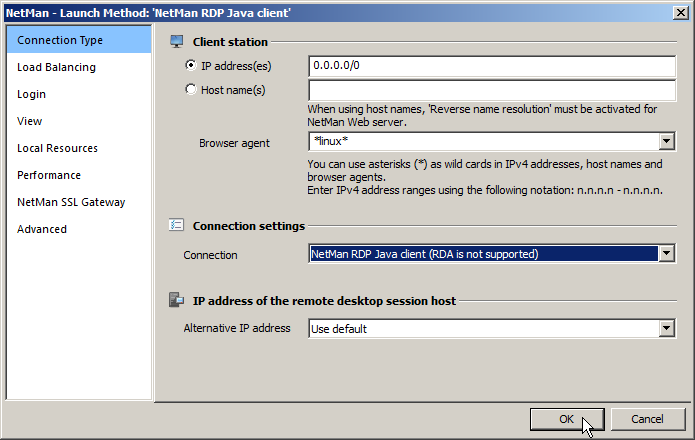NetMan Web Services follow the rules you specify to determine which launch method is applied for client workstations. Edit the existing "0.0.0.0/0" rule or click the "New" button to create a new one.

Set one or more of the following criteria in the NetMan Web Services for determination of the launch method:
•IP address or host name of the client machine
•Browser agent reported by the client station
In the Client station section, specify the stations for which the rule applies. You can specify stations by either IP addresses or host names. For IPv4 addresses, use of the asterisk ("*") as a wildcard is supported. The CIDR text conventions are also supported, and are applied for the specified standard rules.
To use host names, reverse name resolution must be enabled in the NetMan Web Service Settings. You can activate reverse name resolution in the NetMan System Settings on the NetMan Web Service page. For details on enabling reverse name resolution, see "NetMan Web Service". You can also use the "*" wildcard when entering host names, for example to select entire domains.
Parts of the browser agent can also be used in defining the launch method. Workstations report their browser agent every time they access Web services. Click on the 'down' arrow to the right of the "Browser agent" field to see a list of the browser agents from all browsers that already have accessed the server.
Here is an example:

The list shows 9 rules for determining which launch method is applied. The list is processed in the order in which it is shown here, from top to bottom. The first applicable rule found is applied. The following factors are taken into account in determining applicability:
•Client IP address or host name of the client
•Browser agent reported by the client station
•Script-specific session settings that differ from the defaults overwrite the global settings
![]() For details on defining Script-specific session settings, see "Edit Session Settings".
For details on defining Script-specific session settings, see "Edit Session Settings".
If the lara.hh-software.com station accesses NetMan over the Web Interface with the settings configured as shown above, and there are no Script-specific settings to overwrite the defaults, the first rule in this list applies and a web page is opened using the Citrix Java client. If a Linux station in the hh-software.com domain uses the Web Interface for access, the second rule is applied. If, on the other hand, the ICA protocol is explicitly specified in settings for the application called from the hh-software.com domain, the fourth rule in the list, rather than the second, is applied and Citrix web client is the launch method used. For stations within the specified range of IP addresses, Rule 5 launches Scripts in an rdesktop session, because these stations are all thin clients which do not have the performance capacity to run a regular Java Client. The rules defined for the IP address 0.0.0.0/0 for IPv4 and ::/0 for IPv6 are default rules and determine the launch method when none of the preceding rules apply. If you use XenApp, we recommend defining the "Citrix Java client" launch method as the default method, with "NetMan RDP Web Client" defined as the default for the remote desktop environment without MetaFrame.
Criteria are applied in the following order:
•Script-specific settings take precedence over default session settings.
•Which rule is to be used is determined from the analysis of IP address/host name and browser agent.
![]() If the configuration is incorrect, in particular in combination with special settings for individual Scripts, it may be found that none of the rules apply. We recommend formulating simple rules and making sure there is always at least one rule that can be applied in any case. If there is no applicable rule, the NetMan start file is used for access over the Web Interface.
If the configuration is incorrect, in particular in combination with special settings for individual Scripts, it may be found that none of the rules apply. We recommend formulating simple rules and making sure there is always at least one rule that can be applied in any case. If there is no applicable rule, the NetMan start file is used for access over the Web Interface.
![]() Keep in mind that the Launch method can be changed by the client option on the Launch method page of the NetMan Settings allows Web Interface users to configure the launch method in the Web Interface Settings. If you want to restrict your users to the default launch method, make sure this option is deactivated. For details on deactivating this setting, see "Web Interface Launch Methods".
Keep in mind that the Launch method can be changed by the client option on the Launch method page of the NetMan Settings allows Web Interface users to configure the launch method in the Web Interface Settings. If you want to restrict your users to the default launch method, make sure this option is deactivated. For details on deactivating this setting, see "Web Interface Launch Methods".